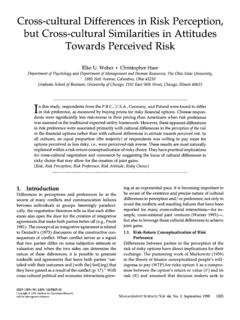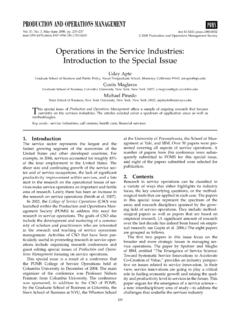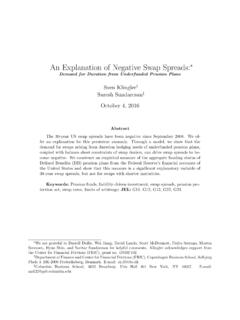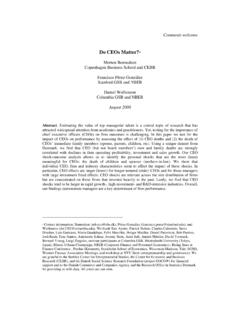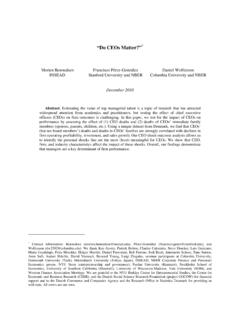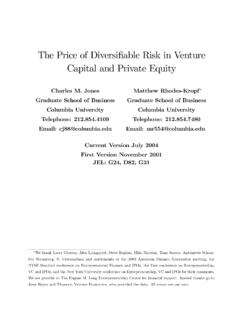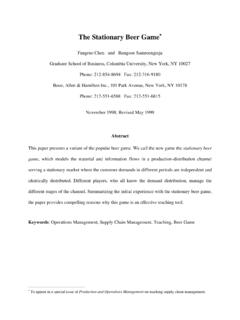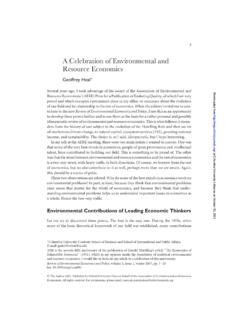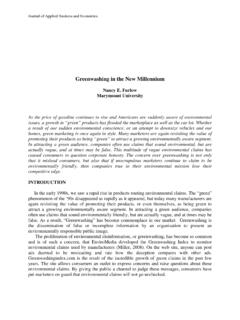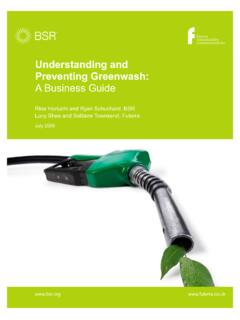Transcription of The Drivers of Greenwashing
1 The Drivers ofGreenwashingMagali A. DelmasVanessa Cuerel BurbanoMore and more firms are engaging in Greenwashing , misleading consumers about their environmental performanceor the environmental benefits of a product or service. The skyrocketing incidence of Greenwashing can haveprofound negative effects on consumer and investor confidence in green products. Mitigating Greenwashing isparticularly challenging in a context of limited and uncertain regulation. This article examines the external (bothinstitutional and market), organizational and individual Drivers of Greenwashing and offers recommendationsfor managers, policymakers, and NGOs to decrease its prevalence.
2 (Keywords: Corporate Social Responsibility,Environmental Policy, green Marketing, Greenwashing )The consumer and capital markets for green products, services, and firmshave been expanding rapidly in the last decade. The consumer marketfor green products and services was estimated at $230 billion in 2009and predicted to grow to $845 billion by the start of 2010,professionally managed assets utilizing socially responsible investing strategies, ofwhich environmental performance is a major component, were valued at $ tril-lion in the , an increase of more than 380 percent from $639 billion in companies are now communicating about the greenness of their productsand practices in order to reap the benefits of these expanding green markets.
3 Greenadvertising has increased almost tenfold in the last 20 years and nearly tripled of 2009, more than 75 percent of S&P 500 companies had website sectionsdedicated to disclosing their environmental and social policies and same time, more and more firms are engaging in Greenwashing , misleading con-sumers about firm environmental performance or the environmental benefits of aproduct or service. Over 95 percent of products surveyed by TerraChoice in 2008/2009 committed at least one of the TerraChoice Seven Sins of Greenwashing . 5 The skyrocketing incidence of Greenwashing can have profound negativeeffects on consumer confidence in green products, eroding the consumer marketfor green products and , Greenwashing can negatively affect64 UNIVERSITY OF CALIFORNIA, BERKELEY VOL.
4 54, NO. 1 FALL 2011 confidence in environmentally friendly firms, eroding the socially respon-sible investing capital market. Greenwashing also entails some risks when con-sumers, non-government organizations (NGOs), or government entities questionfirms claims. For example, green Mountain Power Corporation was targeted byseveral environmental groups for allegedly using polluting combustion technologiesfor their renewable energy sources, which theymarketed as green energy. 7 Likewise, corpora-tions have faced lawsuits for engaging in environ-mental false advertising. For example, Hondasettled a class action suit for false and misleadingstatements regarding the fuel efficiency of a , then, do firms engage in green -washing despite these risks?
5 The current state oflax and uncertain regulation is a key driver handful of authors have begun to make headway in defining the phenom-enon of Greenwashing ,9empirically demonstrating the incidence of Greenwashing ,10describing its effects on consumers11and on firms,12and making suggestions as tohow to address some explanation of firm Greenwashing has beenput forth,14a comprehensive analysis of its determinants is lacking, and as a resultthere are few tools available to managers or policymakers seeking to mitigate green -washing. We aim to fill this void by developing a framework that examines the insti-tutional, organizational, and individual Drivers of Greenwashing and then use thisframework to develop recommendations for how to decrease firm define Greenwashing as the intersection of two firm behaviors: poorenvironmental performance and positive communication about environmentalperformance.
6 Since the Drivers of firm environmental performance are wellunderstood,15we treat it as fixed and focus on firm communication about envi-ronmental performance. That is, we describe the Drivers that lead firms with poorenvironmental performance ( brown firms) to communicate positively abouttheir environmental performance. Given the shorter time frame required for afirm to alter communications about its environmental performance than for a firmto change it, our analytical focus on the Drivers that lead brown firms to commu-nicate positively about environmental performance while holding firm perfor-mance constant is not only useful for analytical tractability, but is also true toshorter-term strategic decisions of managers in these identify the Drivers of Greenwashing , we draw from existing work inmanagement, strategy, sociology.
7 And psychology that has studied and establishedfactors that can influence firm and individual behavior under various circum-stances. Our framework organizes the Drivers of Greenwashing into three levels:external, organizational, and individual. External Drivers include pressures fromboth non-market actors (regulators and NGOs) and market actors (consumers,investors, and competitors). The current regulatory environment is the key driverof Greenwashing . Regulation of Greenwashing is extremely limited in the enforcement of such regulation is highly uncertain. In addition, variation inregulation across countries and complexity regarding appropriate jurisdiction ofMagali A.
8 Delmas is a professor ofmanagement at the UCLA Institute of theEnvironment and Sustainability and theAnderson School of Cuerel Burbano is a studentin Strategy and Policy at the UCLAA nderson School of Drivers of GreenwashingCALIFORNIA MANAGEMENT REVIEW VOL. 54, NO. 1 FALL 2011 practices contribute to a particularly uncertain regulatory environ-ment for multinational corporations. The regulatory context is a critical direct driverof Greenwashing due to the limited punitive consequences. The external marketdrivers of Greenwashing include consumer and investor demand for green products,services, and firms.
9 Organizational-level Drivers include firm incentive structure andethical climate, effectiveness of intra-firm communication, and organizational iner-tia. Such organizational-level Drivers can become more pronounced in a lax regula-tory context as firms face little incentive to put structures and processes in place toalter organizational tendencies. Individual-level Drivers include narrow decisionframing, hyperbolic intertemporal discounting and optimistic bias. These cognitivetendencies become more salient and have a greater effect on individual decisionmaking under conditions of uncertainty and limited or imperfect information, towhich the current regulatory environment provide recommendations for managers, policymakers, and NGOs todecrease the incidence and severity of Greenwashing in practice.
10 More stringent,enforced regulation of Greenwashing would serve as the most direct means to reduceit. However, given that effective implementation of more stringent regulation wouldbe challenging due to a lack of clarity about what constitutes green behavior and con-fusion surrounding the correct use of green adjectives such as biodegradable and all-natural, and it could even have the unintended consequence of decreasingfirms use of otherwise helpful green claims. Given these challenges, it is unlikely thatthere will be significant regulatory change in the near future. However, there areimportant ways that managers, policymakers, and NGOs can work towards decreas-ing the incidence of Greenwashing in the current regulatory context.
